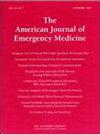急诊科接受免疫治疗的癌症患者免疫相关不良事件的相关因素
IF 2.2
3区 医学
Q1 EMERGENCY MEDICINE
引用次数: 0
摘要
本研究旨在评估在接受免疫检查点抑制剂(ICI)治疗的急诊科(ED)患者中免疫相关不良事件(IRAEs)的发生率,并确定与IRAEs相关的患者特征。方法回顾性研究纳入2017年1月至2024年8月在两所大学医院急诊科就诊的ICI成年患者。如果在住院或随访期间诊断出急性脑损伤,则紧急就诊的原因归为急性脑损伤。解释变量(患者特征)和结果变量(IRAE的存在)之间的关联使用logistic回归和95%置信区间的优势比(ORs)进行评估。结果在研究期间接受ICI治疗的1330例患者中,有484例(36.4%)在治疗开始后就诊,占898次。ED就诊主要为男性(n = 573, 63.8%),中位年龄64岁(IQR 54-73)。急诊科就诊最常见的是黑色素瘤(n = 445, 49.6%)和肺癌(n = 409, 45.5%)。IRAE占135例(15%)急诊。最常见的IRAEs是消化道(31.5%)、内分泌(20.8%)、肝脏(13.7%)、神经肌肉(7.7%)和肺部(6%)。与IRAE显著相关的变量包括男性(OR: 1.67; 95% CI: 1.07-2.60)、腹泻(OR: 3.96; 95% CI: 2.42-6.49)和既往使用过两种(OR: 2.19; 95% CI: 1.01-4.73)或三种ICI药物(OR: 3.59; 95% CI: 1.46-8.82)。最后一次注射ICI的患者在急诊就诊前6个月以上发生IRAE的可能性较小(OR: 0.32; 95% CI: 0.14-0.70)。结论:本研究报告了36%接受ICI治疗的癌症患者在开始治疗后的某个时间点访问了急诊科。在15%的病例中,这些访问与IRAEs有关。腹泻应引起对IRAE(结肠炎)的怀疑,特别是在过去6个月内接受过多种ICI药物的患者。早期发现IRAEs很重要,因为早期干预可能与改善预后有关。本文章由计算机程序翻译,如有差异,请以英文原文为准。
Factors associated with immune-related adverse events in cancer patients treated with immunotherapy visiting the emergency department
Background
This study aimed to estimate the prevalence of immune-related adverse events (IRAEs) in patients treated with immune checkpoint inhibitors (ICI) who visited the emergency department (ED) and to identify patient characteristics associated with IRAEs.
Methods
This retrospective study included adult patients treated with ICI who visited the EDs of two University Hospitals between January 2017 and August 2024. The reason for emergency visit was attributed to IRAE if a diagnosis of IRAE was made during hospitalization or follow-up. Associations between explanatory variables (patient characteristics) and the outcome variable (presence of IRAE) were assessed using logistic regression and odds ratios (ORs) with 95 % confidence intervals [CI95 %].
Results
Among the 1330 patients who received ICI during the study period, 484 (36.4 %) visited the ED after treatment initiation, accounting for 898 visits. ED visits involved predominantly males (n = 573; 63.8 %), with median age of 64 years (IQR 54–73). The ED visits concerned most commonly patients with melanoma (n = 445, 49.6 %) and lung cancer (n = 409, 45.5 %). IRAE accounted for 135 (15 %) emergency visits. The most frequent IRAEs were digestive (31.5 %), endocrine (20.8 %), hepatic (13.7 %), neuromuscular (7.7 %), and pulmonary (6 %). Variables significantly associated with IRAE included male sex (OR: 1.67; 95 % CI: 1.07–2.60), diarrhea (OR: 3.96; 95 % CI: 2.42–6.49), and prior treatment with two (OR: 2.19; 95 % CI: 1.01–4.73) or three ICI drugs (OR: 3.59; 95 % CI: 1.46–8.82). Patients whose last ICI injection occurred more than six months before the emergency visit were less likely to experience IRAE (OR: 0.32; 95 % CI: 0.14–0.70).
Conclusion
This study reports that 36 % of patients with cancer treated with ICI visited the ED at some point after initiating treatment. These visits were related to IRAEs in 15 % of the cases. Diarrhea should prompt suspicion of IRAE (colitis), especially in patients who have received multiple ICI drugs within the last six months. Early recognition of IRAEs is important because early intervention may be associated with improved outcomes.
求助全文
通过发布文献求助,成功后即可免费获取论文全文。
去求助
来源期刊
CiteScore
6.00
自引率
5.60%
发文量
730
审稿时长
42 days
期刊介绍:
A distinctive blend of practicality and scholarliness makes the American Journal of Emergency Medicine a key source for information on emergency medical care. Covering all activities concerned with emergency medicine, it is the journal to turn to for information to help increase the ability to understand, recognize and treat emergency conditions. Issues contain clinical articles, case reports, review articles, editorials, international notes, book reviews and more.

 求助内容:
求助内容: 应助结果提醒方式:
应助结果提醒方式:


